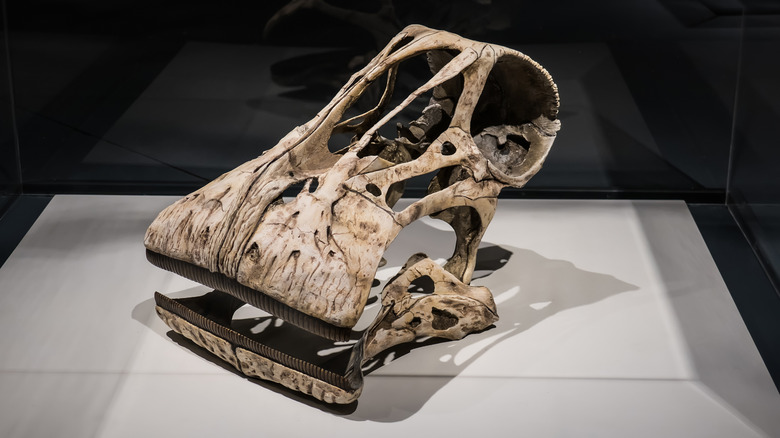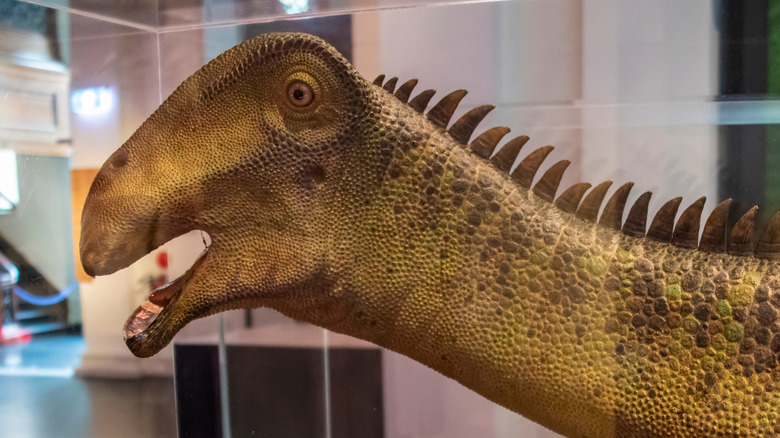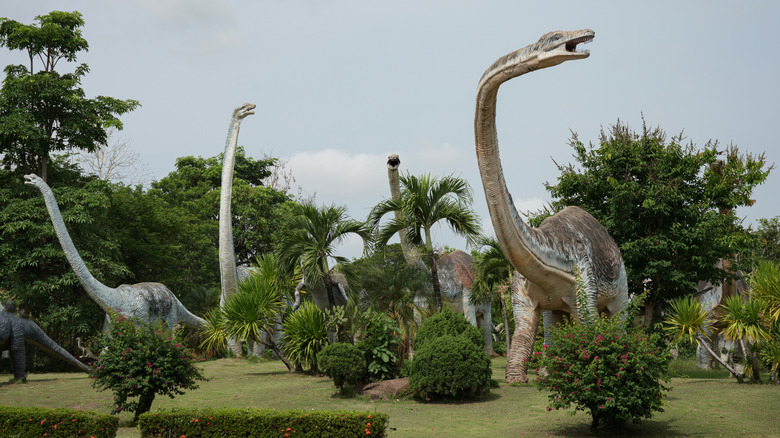The Obscure Dinosaur Species That Had 500 Teeth
This planet once played host to a massive dinosaur that packed more than 500 teeth into its jaws. That might sound like a terrifying prospect at first, but the creature in question wasn't a vicious beast with a mouth full of knives. It was a grazing herbivore called Nigersaurus taqueti and it only takes one glance to see why it is one of the most unusual dinosaur species ever discovered to date. Its skull looks like a binder clip, with teeth arranged in perfectly straight lines. It's so alien in appearance that it left paleontologists stumped for decades.
Nigersaurus (pronounced "nee-zhayr-sore-us") is named for the country of Niger, where its bones were first discovered. Fossils of the species were found as early as the 1960s, but they were amidst a vast bonebed with so many specimens to explore that it took 30 years before anyone actually identified Nigersaurus for what it was.
Paleontologist Paul Sereno, who led the team that identified the species, was so baffled by its jawbone when he initially saw it that he first theorized it could come from the ancient fish known as a coelacanth. But then, CT scans revealed something shocking. Within the bones were rows upon rows of hidden teeth, amounting to over 500 in total. That wasn't even the strangest feature, as it is the arrangement of these teeth that truly calls attention, and paints a vivid picture of how this dinosaur lived 105 million years ago.
The one of a kind jaws of Nigersaurus
Both the upper and lower jaws of Nigersaurus featured roughly 60 thin, needlelike teeth packed tightly together. Now, you might be thinking, "Hang on. 60 teeth on each jaw only makes 120 in total," but this is where things get truly strange. When paleontologists conducted CT scans of Nigersaurus' jawbone, they discovered that every tooth had additional teeth positioned directly below it, forming columns of five to 10 teeth each. All told, Nigersaurus had more teeth than any other known dinosaur.
The tooth columns in Nigersaurus's mouth are known as dental batteries. The basic idea is that, as the dinosaur grazed, its teeth wore down, and eventually, they would fall out. At that point, the next tooth in the battery would rise up to fill the space, and a new tooth would form at the bottom of the column. Dinosaur teeth have lines on them that tally age, like the rings of a tree, and based on this, paleontologists believe that each of Nigersaurus's teeth only lasted two weeks before it needed to be replaced. This is the highest replacement rate of any known dinosaur.
The reason that Nigersaurus' teeth had to be replaced so often is due to the dinosaur's diet. Nigersaurus was a grazer, but in its day, grasses had not yet evolved. Instead, it fed on ancient plants like horsetail, which contains silica crystals that would have been highly abrasive to the teeth, grinding each one down in a matter of days.
How Nigersaurus compares to other sauropods
Nigersaurus was a sauropod, the clade of long-necked dinosaurs, and while it had some traits in common with other, better-known sauropods like brontosaurus, brachiosaurus, and diplodocus, it was certainly a black sheep within the group. Nigersaurus was roughly 30 feet long and its maximum weight has been estimated at just over four tons, making it about the size of an elephant. That's big by today's standards, but it actually put Nigersaurus near the bottom of the sauropod clade. This is especially intriguing because Nigersaurus lived during the Cretaceous period, a time when sauropods around the world were generally growing larger, culminating in Patagotitan, the largest dinosaur ever discovered.
Because of its smaller size and shorter neck, Nigersaurus would not have been able to eat from treetops like other sauropods, hence it developing a totally unique jaw in comparison. It does, however, share another unusual feature with its sauropod brethren. The bones of Nigersaurus are extremely fragile, thin enough for light to shine through. That's because sauropod bones were hollow and filled with air, making their bodies significantly lighter than they initially appear. This is how sauropods were able to reach giant sizes without collapsing under their own mass. Portions of Nigersaurus' skeleton actually had more air than bone. Unfortunately, the fragile nature of these bones has made them difficult to study, and Nigersaurus may have had even more amazing features that remain a mystery to us.


